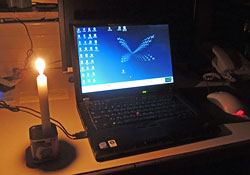
We often comment on how attached we’ve become to computing technology, how we’ve made it play a central role in our life – like electricity, like fire, like stone tools in earlier eras. One way to think of it is how lost we’d be without the technology; but another is to consider how resolutely we refuse to have it taken from us. Last month I had a glimpse into that…
This December we had a major snowstorm that caused massive infrastructure damage leaving my home without electrical power for a few days and without our telephone and internet lines for all of two weeks. A good opportunity, you’d think, to see how life was in the middle ages… Right?
Wrong, of course. It was interesting to see how completely we managed to work around the limitations imposed on us by the storm. I never really gave thought to how many fallbacks we have in place to ensure we can stay connected!
The first order of the day was of necessity heating: right at the bottom of Maslow’s pyramid. In my case this was solved with a kerosene heater I’d stashed away years ago… an excellent heat source, and totally self contained (if you stock some fuel), which turns out to be a great virtue in a pinch. For light we had ample choice: wax candles, an emergency lantern with a lead battery, a butane powered Coleman lantern, and the many LED flashlights that have accumulated around the house – the switch to LED brought with it very long battery life, and in any case I had a bunch of spare batteries.
Phone connectivity was easy, given cellular access – as long as the battery lasted; then I had to rely on my car, whose gas tank translates to an ample source of electricity via the cellular adapter plugged into that throwback, the cigarette lighter jack.
Internet was flaky but my Smartphone gave access and – in USB tethering mode – allowed my notebook to connect now and then as well. The notebook’s battery was the biggest worry, but after a while electricity started to appear for a few hours a day so I managed fairly well.
What all this meant is that while we were far from comfortable, we could continue to work from home most of the time. We had enough redundancy… On the other hand , it was a major hassle to keep things running – keeping track of battery status on multiple devices, scrambling to charge them up from car or whichever wall outlet spluttered to brief life… or trudging through the snow to a friend’s home where they might have power at the moment.
And at the end of the day, as I’m making a shopping list to prepare for the next storm, I can’t help but think of the food chain: it all goes down to having a self-contained, independent power source and the ability to convert it to what all those devices need. A small generator with a goodly supply of gasoline may be the most versatile solution for electronics and lighting, while kerosene is definitely a great heating solution.
We’ve come a long way from the days when a boy scout could “be prepared!” with a candle and some matches… but we can manage to keep the electronics we’ve weaved into our lives functioning with a little foresight. And, mind you, some matches – these once ubiquitous fire-makers may be absent from many a home these days!

